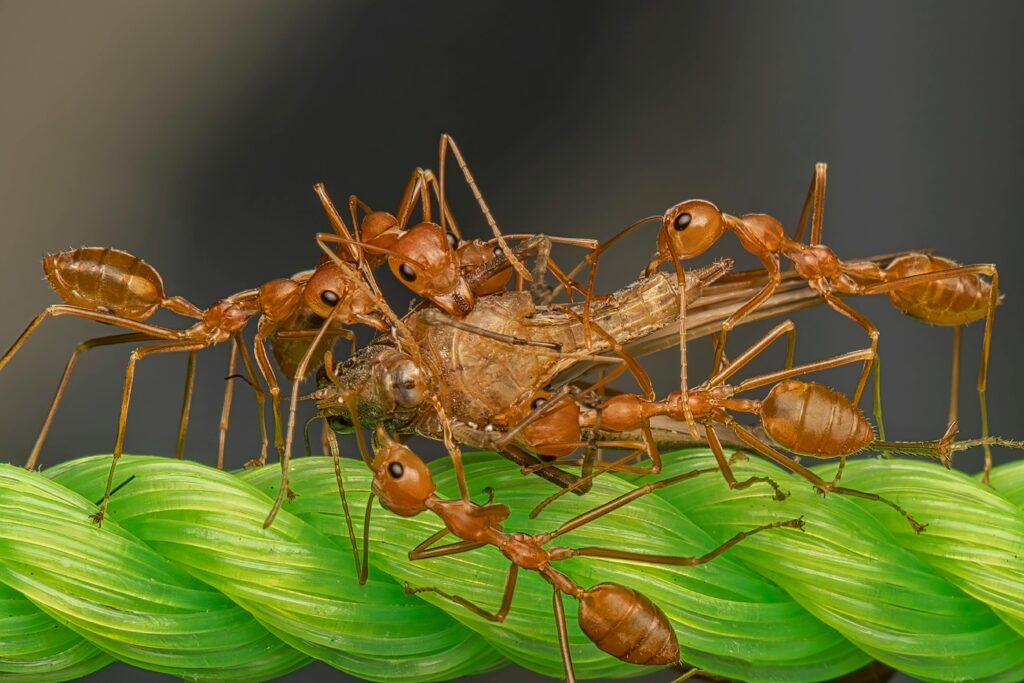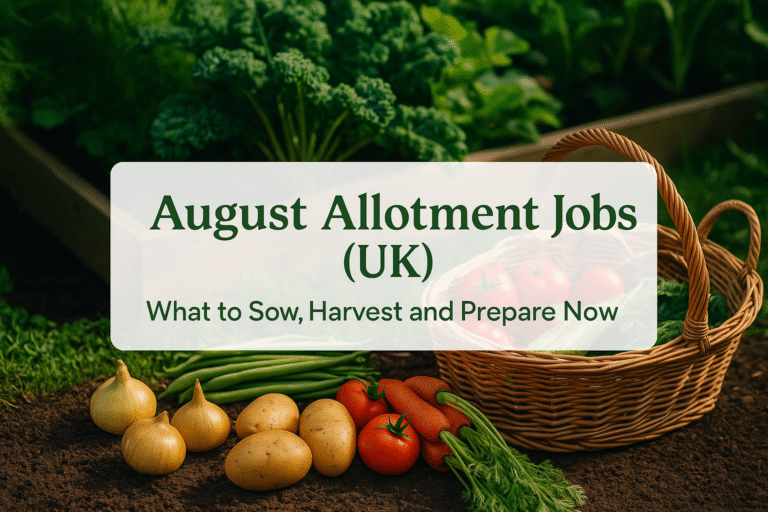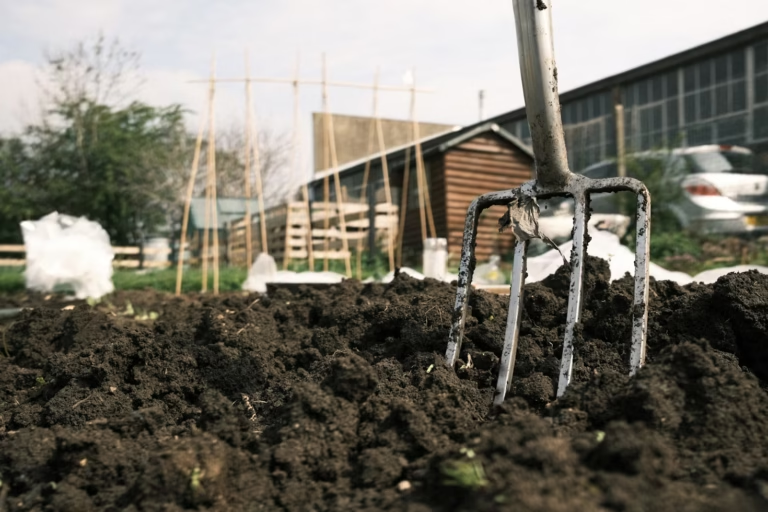Some of the links in this post may be affiliate links. If you decide to buy through them, it helps us grow Sprout Share.
Thank you for your support.

Keywords: organic pest control, natural pest management, sustainable gardening, beginner gardening, UK garden pests, allotment gardening, integrated pest management
When we lifted the tarp from our initial allotment clearing, what we discovered underneath wasn’t quite what we’d hoped for. Hundreds of red ants had made themselves comfortable in the dark, moist conditions we’d unintentionally created. What started as an efficient way to suppress weeds had become an ant nursery, a perfect example of why organic pest control knowledge is so essential for every gardener.
If you’re reading this, chances are you’ve encountered something similar. Maybe not exactly red ants under a tarp, but that moment when organic pest control suddenly becomes very personal. Perhaps it’s aphids clustering on your carefully tended beans, mysterious holes appearing in your lettuce overnight, or discovering that your thriving seedlings have become someone else’s dinner.
These discoveries can feel disheartening, especially when we’re working so hard to create healthy, sustainable growing spaces. But here’s what our allotment journey has taught us: pest challenges aren’t a sign that we’re failing at gardening, they’re simply part of learning to work with the natural world around us.
In fact, 36% of individuals in the UK currently cultivate their own homegrown herbs, fruit, and vegetables, and 46% of gardeners are choosing organic pest control methods, avoiding chemicals to protect their soil and the wider environment. We’re all navigating this together, seeking natural pest management approaches that honour both our crops and the ecosystem we’re part of.
Let’s explore natural pest management strategies that actually strengthen our gardens for the long term, starting with what we learned from our own red ant discovery.
Understanding the Red Ant Reality
Before we dive into solutions, let’s acknowledge what we’re dealing with. Red ants (often garden ants that appear reddish-brown) aren’t inherently destructive to plants, but they can indicate underlying issues like aphid infestations, as they farm these sap-sucking insects for their sweet honeydew. They also disturb plant roots when building their colonies and can make harvesting and garden maintenance frustrating.
The good news? We can address ant problems through organic pest control methods while actually improving our garden’s overall health.
Organic Pest Control: Prevention First
1. Build Resilient Soil Communities for Organic Pest Control
Healthy soil is our foundation for everything else. When we create diverse, living soil communities, we’re essentially building our garden’s immune system. Well-draining soil that’s rich in organic matter is less attractive to ants, who prefer disturbed or compacted areas for nest building.
Practical steps:
- Add compost regularly to improve soil structure
- Avoid walking on wet soil to prevent compaction
- Consider raised beds or defined pathways if soil compaction is an ongoing issue
- Use organic mulch to maintain consistent moisture levels
2. Encourage Natural Predators
Rather than fighting nature, we can work with it. Species providing pest control, such as the 2-spot ladybird, have declined by 34%, which means we need to actively encourage these helpful creatures back into our spaces.
Creating habitat:
- Plant native flowers that attract beneficial insects
- Provide water sources like shallow dishes or bird baths
- Leave some ‘wild’ areas with logs or stone piles for predator habitat
- Avoid broad-spectrum treatments that harm helpful insects alongside pests
3. Strategic Plant Partnerships
Ants are repelled by the strong scents of citrus, vinegar, and cinnamon, and we can use this knowledge in our planting schemes. Companion planting isn’t just about maximising space. It’s about creating natural deterrent systems.
Natural ant deterrents to grow:
- Mint (contained in pots to prevent spreading)
- Tansy
- Pennyroyal
- Cinnamon basil
- Lavender around garden borders
When Prevention Isn’t Enough: Organic Pest Control Solutions
Sometimes, despite our best efforts, we need to take more direct action. Here’s how to do it without disrupting the entire ecosystem we’re trying to nurture.
4. Physical Barriers and Disruption
For immediate relief, especially around vulnerable seedlings or harvest areas, physical methods can be surprisingly effective:
Barrier methods:
- Diatomaceous earth (food grade) sprinkled around affected areas
- Coffee grounds scattered near ant trails (bonus: they improve soil as they decompose)
- Copper tape around raised bed edges
- Sticky traps for flying ants during summer swarms
Disruption techniques:
- Regularly disturb ant trails with a hoe or rake
- Pour boiling water directly on ant hills (use sparingly and only on serious infestations)
- Sprinkle the tree with peppermint oil water-based solution. You need 30 drops max per one gallon
5. Natural Deterrent Sprays
When we need something stronger than physical barriers but gentler than commercial pesticides, homemade sprays can provide effective relief:
Vinegar solution: Mix equal parts white vinegar and water, spray directly on ant trails and entry points. Reapply after rain.
Essential oil spray: Combine water with a few drops of peppermint, tea tree, or lemon oil. This disrupts scent trails without harming beneficial insects.
Soap spray: A weak solution of natural soap and water can deter ants while being safe for plants and soil life.
6. Targeted Biological Controls
For persistent ant infestation and to keep ants at bay, biological controls like beneficial nematodes can be applied at 4-weekly intervals. These microscopic beneficial organisms specifically target ant larvae without affecting other garden life.
Nematodes represent the cutting edge of sustainable pest management. They’re completely natural, safe for pets and children, and won’t harm beneficial insects or soil organisms.
7. The Recovery Plan: Healing Your Garden
Once we’ve addressed the immediate ant problem, the real work begins: helping our garden recover and become more resilient.
Immediate recovery steps:
- Gently replant any disturbed seedlings
- Water stressed plants thoroughly but avoid overwatering
- Apply diluted liquid fertiliser to help plants recover from root disturbance
- Monitor for secondary pest problems that might take advantage of stressed plants
Long-term resilience building:
- Continue adding organic matter to improve soil structure
- Establish permanent plantings that deter ants naturally
- Create diverse plantings that support beneficial insects
- Keep detailed records of what works in your specific conditions
UK-Specific Resources for Ongoing Support
- Royal Horticultural Society (RHS): Comprehensive pest identification and organic control advice
- Garden Organic: Specialist organic gardening guidance and pest management
- Buglife: Understanding beneficial insects and creating habitat
- National Allotment Society: Community pest management strategies
- Centre for Alternative Technology: Sustainable growing practices and natural pest control
Moving Forward with Confidence
Remember, dealing with garden pests is a learning process, not a one-time fix. Each season brings new challenges and opportunities to refine our approach. What works beautifully in one garden might need adjustment in another, and that’s perfectly normal.
The goal isn’t to eliminate all pests, it’s to create a balanced ecosystem where problems don’t spiral out of control. When we see a few ants in our garden, we can view them as information rather than immediate threats. They might be telling us about soil compaction, moisture issues, or aphid populations we haven’t noticed yet.
The most successful pest management comes from patience, observation, and willingness to try different approaches. Some years we’ll have more challenges than others, and that’s part of the natural rhythm of gardening.
Our next steps together:
- Try one or two of these approaches rather than attempting everything at once
- Keep notes on what works in your specific conditions
- Share experiences with other gardeners, their insights often prove invaluable
- Remember that healthy soil and diverse plantings prevent more problems than any single intervention


